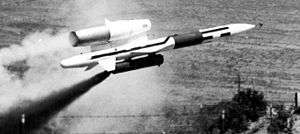North American MQM-42
The MQM-42 was a supersonic target drone developed by North American Aviation (from 1967 North American Rockwell). Developed in two subvariants, Redhead and Roadrunner, it was used by the United States Army in the 1960s and 1970s.
| MQM-42 Redhead/Roadrunner | |
|---|---|
 | |
| Launch of a MQM-42 | |
| Role | Target drone |
| National origin | United States |
| Manufacturer | North American Aviation |
| First flight | 1961 |
| Primary user | United States Army |
Design and development
Given the company designation NA-273, the Redhead/Roadrunner drone program produced a small aircraft of largely conventional design, with small delta wings and a downswept tailplane; the vertical stabilizer doubled as a pylon for the aircraft's ramjet engine. A solid-propellant rocket provided thrust until the ramjet reached operating speed; launch was from the same launcher as that used by the MGR-3 Little John battlefield rocket.[1] Two minor variants of the drone were produced; 'Redhead' was optimized for high-altitude flight, at heights of up to 60,000 feet (18,000 m), while 'Roadrunner' was a variant for low-altitude operation as low as 300 feet (91 m) above the ground, and both could reach speeds of between Mach 0.9 and Mach 2. An autopilot, set to maintain a preset altitude, provided control of the drone; radio command guidance from a ground control station could override the autopilot. At the end of a flight, if the target drone had not been shot down, recovery could be either on command from the ground station, or automatic in case of fuel exhaustion or loss of control; a retrorocket would decelerate the drone to allow for deployment of a recovery parachute.[2]
Operational history
First flight of the NA-273 took place in 1961; in 1963, the designation MQM-42A was applied to both variants. The MQM-42 was used primarily to provide training in tracking and engaging targets for the MIM-23 Hawk surface-to-air missile;[3] it remained in service with the United States Army through the mid-1970s.[2]
Specifications (MQM-42A)
Data from Parsch 2007[2]
General characteristics
- Crew: None
- Length: 24 ft 10 in (7.57 m)
- Wingspan: 6 ft 3 in (1.91 m)
- Gross weight: 900 lb (408 kg)
- Powerplant: 1 × Marquardt MA-74 ramjet, 1,790 lbf (8.0 kN) thrust
- Powerplant: 1 × Rocketdyne solid-fuel rocket booster, 6,000 lbf (27 kN) thrust
Performance
- Maximum speed: Mach 2+
- Range: 250 mi (400 km, 220 nmi)
- Service ceiling: 60,000 ft (18,000 m)
See also
Aircraft of comparable role, configuration and era
Related lists
References
Citations
- Jane's 1965-1966, p. 455.
- Parsch 2007
- Haggerty 1968, p. 185.
Bibliography
- Haggerty, James J. (1968). 1968 United States Aircraft, Missiles and Spacecraft. Washington D.C.: National Aerospace Education Council. ASIN B005PPVSQK.
- Parsch, Andreas (1 July 2007). "North American MQM-42 Redhead/Roadrunner". Directory of U.S. Military Rockets and Missiles. Designation-Systems. Retrieved 2017-12-19.
- Taylor, John W. R. (1965). Jane's All the World's Aircraft 1965-1966. London: Sampson Low, Marston & Company. ASIN B000ID5QBC.